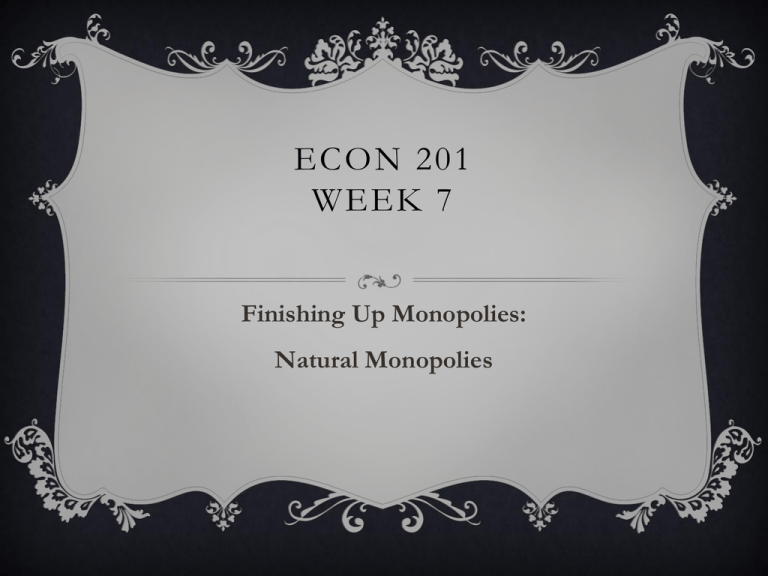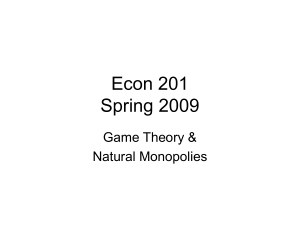ECON 201 WEEK 7 Finishing Up Monopolies: Natural Monopolies
advertisement

ECON 201 WEEK 7 Finishing Up Monopolies: Natural Monopolies NATURAL MONOPOLIES natural monopoly • one firm can produce a desired output at a lower social cost than two or more firms— • there are economies of scale • Having multiple firms providing a good or service is less efficient than if a single firm provided a good or service. • Examples of claimed natural monopolies include railways, telecommunications, water services, electricity, and mail delivery. An industry is said to be a natural monopoly if only one firm is able to survive in the long run, • result of high fixed costs of entering an industry which causes long run average costs to decline as output expands FIGURE 13.7 A Natural Monopoly A natural monopoly is a firm in which the most efficient scale is very large. Here, average total cost declines until a single firm is producing nearly the entire amount demanded in the market. With one firm producing 500,000 units, average total cost is $1 per unit. With five firms each producing 100,000 units, average total cost is $5 per unit. MARKET CONDITIONS FOR A NATURAL MONOPOLY Scale is such that it is cost-efficient for only 1 firm to supply the market, i.e., economies of scale THE REGULATOR’S DILEMMA A couple of alternatives: • No regulation • Firm will price like a monopolist • Set price at ATC • Rate-of-return regulation: sets utility’s prices based on cost-of-service WHAT ARE THE CONSEQUENCES? Do nothing • Firm chooses Q at the point where MR = MC • Less than perfect competition • Sets Price > MC • Higher than perfect competition • Higher price and lower Q => deadweight loss WHAT H A P P E N S I F W E D O N ’ T R E G U L AT E? Unregulated Monopolist MR = MC Ideal Output P=MC WHAT ARE THE CONSEQUENCES Rate-of-return regulation: • Set rates such that they cover firm’s cost + normal rate of return Set price = ATC • Since ATC is falling => MC < ATC • And P = ATC > MC • Still producing too little – would like P= MC at Q* WHAT’S THE DOWNSIDE TO MONOPOLIES? Economically inefficient • Deadweight loss • Higher price and lower quantity demanded/supplied • Efficiency loss: consumers MV (WTP) > MC of resources used to produce the good • Transfer losses • From CS to PS • Economists have no opinion • Pareto efficient: winners can (potentially) compensate losers • No/less incentive for innovation 10 MARGINAL-COST PRICING FOR A NATURAL MO NOPOLY Price Average total cost Average total cost Loss Regulated price Marginal cost Demand 0 Quantity Because a natural monopoly has declining average total cost, marginal cost is less than average total cost. Therefore, if regulators require a natural monopoly to charge a price equal to marginal cost, price will be below average total cost, and the monopoly will lose money. 10 Rate of Return Price = ATC France P= MC THE EUROPEAN APPROACH Assuming LRAC is still falling • Set P = MC • Subsidize the difference between ATC and P MC 10 THE FRENCH APPROACH: P=MC + SUBSIDY Price Average total cost Average total cost Subsidy Regulated price Marginal cost Demand 0 Quantity Because a natural monopoly has declining average total cost, marginal cost is less than average total cost. Therefore, if regulators require a natural monopoly to charge a price equal to marginal cost, regulator will have to subsidize the “loss” – difference between ATC and price 13 REGULATORY RESPONSES doing nothing setting legal limits on the firm's behaviour, either directly or through a regulatory agency setting up competition for the market (franchising) setting up common carrier type competition setting up surrogate competition ("yardstick" competition or benchmarking) requiring companies to be (or remain) quoted on the stock market public ownership Since the 1980s there is a global trend towards utility deregulation, in which systems of competition are intended to replace regulation by specifying or limiting firms' behaviour; the telecommunications industry is a leading example globally. TELECOMMUNICATIONS – AN EXAMPLE Natural monopolies tend to be associated with industries where there is a high ratio of fixed to variable costs. • • fixed costs of establishing a national distribution network for a product might be enormous, but the marginal (variable) cost of supplying extra units of output may be very small. average total cost will continue to decline as the scale of production increase, because fixed (or overhead) costs are being spread over higher and higher levels of output The telecommunications industry has in the past been considered to be a natural monopoly. Like railways and water provision, • • existence of several companies supplying the same area would result in an inefficient multiplication of cables, transformers, pipelines etc. perception of what constitutes a natural monopoly is now changing – • new technology reduces traditional barriers to entry within markets. telecommunications industry • • in the UK, British Telecom has faced increasing levels of competition from new telecommunications service providers during the 1990s - not least the rapid expansion of mobile and cable services. T this has led to a change in the role of the industry regulator (OFTEL). Its main role now is not necessarily the introduction of even more competition into the telecommunications industry - but a policing role to ensure fair competition between service providers.




